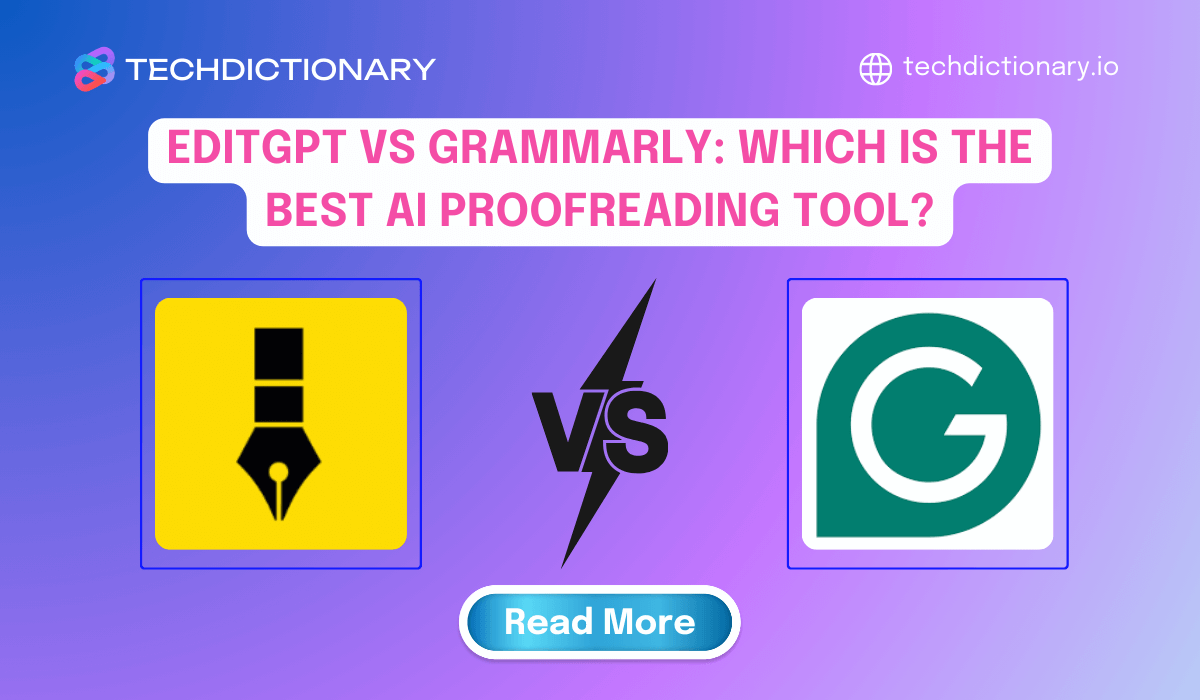
With AI writing tools becoming more popular than ever, many of us are asking, “Which tool is really better for my needs?”. If you’re looking for an AI proofreader, this in-depth comparison of editGPT vs. Grammarly will help you make an informed decision.
We’ll break down how each tool works, where it shines, where it falls short, and look at real-world tests to help you choose your perfect writing partner. Let’s explore!
editGPT is an advanced AI proofreader that specializes in deep, contextual editing. It goes beyond basic error-checking to analyze the true tone, voice, and intent behind your writing. The result is human-like suggestions that refine your content while preserving your unique style. Offering features like custom prompts and advanced rewriting, it’s a strong choice for writers, editors, students, and researchers who require more than just a simple grammar fix.

editGPT Proofreading Tool’s
Grammarly is the most popular and well-known proofreading tool on the market today. It’s an AI-powered writing assistant that excels at providing real-time grammar, spelling, and punctuation checks. TechDictionary recognizes its incredible convenience, with browser extensions and integrations that work across most platforms where you write. While it’s fantastic for quick edits, daily emails, and basic proofreading, its suggestions are primarily rule-based and sometimes lack the deep contextual understanding needed for creative or highly nuanced pieces.

Grammarly Proofreading Tool’s Homepage
Before we break down each feature in detail, let’s take a moment to understand what makes these two tools different at a glance with this quick comparison table:
| Feature | editGPT | Grammarly |
| Contextual Accuracy | Strong, excels at understanding nuanced meaning & context. | Good for standard errors, but can miss contextually incorrect words. |
| Core AI Technology | Acts like a human editor, focusing on intent, tone, and flow. | Rule-based, focuses on applying established grammar rules. |
| Suggestion Quality & Rephrasing | High-quality, non-robotic rewrites; customizable with prompts. | Good for basic clarity and conciseness, suggestions can sometimes feel generic. |
| Integrations & Accesibility | Good (copy-paste, Word import/export, works with ChatGPT). | Excellent (browser extensions, MS Word, Google Docs, etc.). |
| User Experience & Interface | Intuitive interface designed for focused, deep editing. | Very user-friendly and convenient for quick, on-the-fly corrections. |
Now let’s break down each of these five key features in detail.
A great proofreader should understand what you mean, not just what you typed. Techdictionary tested both tools on a passage with correctly spelled but contextually incorrect words, a classic challenge for AI.
The Test: “To complete the experiment, the lab assistance needed to measure the solution’s viscosity carefully. Later, the team celebrated their breakthrough with a bottle of vintage desert wine.”
The intended words here are “assistant” (a person) and “dessert” (a type of wine). Let’s see who passed the test.
editGPT’s Performance (2/2):
As indicated by our test, editGPT excels in this area. It successfully identified both contextual errors, demonstrating a strong ability to understand the meaning behind the words. It suggested changing “assistance” to “assistant,” recognizing that a person was needed to perform the lab work, and also caught that “desert” should be “dessert” in the context of a celebratory wine.

editGPT’s Proofreading Functionality
Grammarly’s Performance (1/2):
In the same test, it successfully identified that “assistance” was the wrong word choice in the context of a “lab” and correctly suggested changing it to “assistant.” However, it completely missed the second contextual error, failing to flag the incorrect use of “desert” wine when the context of a celebration strongly implies “dessert” wine. This indicates that while its contextual abilities are present, they may not be as consistently deep or reliable as editGPT’s for more subtle mistakes.

Grammarly’s Proofreading Functionality
You may be interested in:
Copy AI vs Grammarly: Which is best for an AI Writing Tool?
Wordtune vs Grammarly (2025): Which Is The Best AI Writing Tool?
The “brains” behind each tool are built for different purposes, which directly impacts the user experience.
TechDictionary wanted to know: would they try to “fix” the personality out of it, or would they understand the author’s intent? We fed both tools the same short, conversational paragraph full of personality, slang, and a few intentional quirks.

editGPT’s Core AI Technology
As results showed, editGPT’s technology feels more like a collaborative human editor. It understood the assignment! When we gave it our quirky paragraph, it made only a few, very subtle changes. Crucially, it left the conversational tone, the short, punchy sentences, and the creative flair completely intact. It pays attention to the voice and tone you’re trying to achieve rather than just applying rules by the book. This is why its suggestions often feel more intelligent and human-like.

Grammarly’s Core AI Technology
Grammarly’s AI, while powerful, clearly operates on a more rule-based system. Its suggestion didn’t just offer a few fixes; it proposed a complete rewrite of the entire paragraph to “improve sequence for clarity and impact.” It changed “the deadline is just laughing at me” to “the deadline taunts me,” “My brain? Empty.” to “My mind? Empty.”, and “packed its bags and went on” to “packed up and left.” While the result was grammatically flawless and perhaps more “structured,” it completely stripped the original paragraph of its personality, humor, and unique voice.
What kind of help do you get when you actually want to change something, not just fix it? This is where the quality and flexibility of suggestions really matter.
To see this in action, TechDictionary took a bland, purely informational paragraph about a software product.

editGPT’s Paraphrasing Function
As our test shows, editGPT’s suggestions are focused on enhancing the existing text with more dynamic and impactful language. It identified weaker words and offered stronger, more descriptive alternatives:
The key here is that editGPT maintained the original sentence structure but elevated the vocabulary, acting like an editor sharpening the language. This aligns with its strength in offering thoughtful, non-robotic rewrites that you can review and accept piece by piece.

Grammarly’s Paraphrasing Function
Grammarly’s suggestion took a different, more strategic approach. Instead of just swapping words, it identified a core weakness: the paragraph was written in the first-person (“Our,” “We believe”). Its suggestion was to “Eliminate first-person and add evidence-backed language.” It then provided a completely rewritten version.
This rewrite is a significant improvement in professionalism and tone. It’s a fantastic suggestion for clarity and impact, but it’s a “take it or leave it” full-paragraph rewrite rather than a series of smaller, more granular suggestions like editGPT’s.
A proofreader is only useful if you can use it easily where you work.
This is where Grammarly has an advantage. It offers excellent integrations through browser extensions for Chrome, Safari, etc., and works directly within platforms like Microsoft Word, Google Docs, and various email clients, providing convenient, real-time feedback.
editGPT, on the other hand, primarily functions as a powerful standalone editor. While it lacks the pervasive browser extensions of its competitor, it’s designed for a seamless copy-paste workflow and works well in conjunction with AI writing tools like ChatGPT.
editGPT’s interface is intuitive and is highly regarded for its clear change tracking view. This allows users to easily see what has been added or removed, as well as accept or reject each suggestion, giving them a high level of control over the editing process.
Grammarly is known for its clean, user-friendly interface that requires very little learning curve. Its real-time suggestions make it incredibly convenient for quick, on-the-fly corrections without disrupting your writing flow.
You may be interested in:
QuillBot vs. Grammarly: Which is Better in 2025?
Paperpal Vs Grammarly: Find Out the Best Writing Tool in 2025
|
Pros |
Cons |
|
| editGPT | ✅ Understands nuanced meaning.
✅ Suggestions preserve the writer’s tone and intent, and feel less robotic. ✅ Custom prompts (“make it persuasive,” “make it academic”) give you immense control. ✅ Shows what’s been added/removed, allowing you to accept/reject changes. ✅ Supports over 80 languages, including 20+ business languages. |
❌Fewer direct integrations, relies more on copy-paste or Word import/export. |
| Grammarly | ✅ Great for quick grammar, spelling, and punctuation checks as you type.
✅ Works everywhere with browser extensions, MS Word/Google Docs plugins, etc. ✅ The free version offers basic tone detection, with more in Premium. ✅ Easy to use for beginners with a clean interface. |
❌Can miss nuanced, contextual errors if the spelling is technically correct.
❌Suggestions are rule-based and can sometimes make writing sound generic or flatten your voice. ❌May incorrectly flag humor, slang, or idiomatic expressions as errors. |
Both tools offer a free starting point, but their paid plans unlock their full potential. Here’s how they compare:
| Plan Tier | editGPT | Grammarly |
| Free | $0 / month
– 10,000 words/month – Limited 600 words/request – Multi-language support – Data safety and privacy – Accept and reject changes |
$0 / month
– Basic grammar, spelling, and punctuation checks – Tone detection – 100 AI prompts/month |
| Pro | Pro: $10 / month
– 300,000 words/month – Limited 10,000 words/request – Long-form editing, batch editing, custom prompts, Word import/export – Data safety and privacy |
Pro: $12 / month (billed annually)
– Full-sentence rewrites, clarity, tone, – Tone detection – Write fluently in English – Unlimited personalized suggestions – Detect plagiarism and AI-generated text – 2000 AI prompts/month |
| Elite/Enterprise | Elite: $25 / month
– 2,000,000 words/month – Limited 10,000 words/request – All Pro features |
Enterprise: (Contact sales)
– Generate text with unlimited AI prompts – BYOK encryption – Dedicated support – Custom roles and permissions – Data loss prevention – Cost center visibility |
| Business | Business: $100 / month
– Unlimited words each month – Unlimited requests – Includes 4 user seats – Team management tools – Access to all Pro and Elite features |
N/A |

editGPT Pricing Plans

Grammarly Pricing Plans
When choosing an AI proofreading tool, here are the key factors to consider:
You may be interested in:
Grammarly vs ProWritingAid: Which is better for proofreading in 2025?
Grammarly vs LanguageTool: Which Grammar Checker Wins in 2025?
After a detailed comparison between editGPT and Grammarly, Techdictionary believes that you have a clearer view to choose. Both stand out in different aspects. Grammarly is suitable for fast, real-time proofreading with convenient integration and rule-based grammar checking. On the other hand, editGPT excels at in-depth, contextual editing and preserves your voice, ideal for those who want to elevate their content.
If you still haven’t found the perfect AI tool, save a bookmark for TechDictionary today to discover more useful comparisons and reviews.

